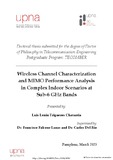Mostrar el registro sencillo del ítem
Wireless channel characterization and MIMO performance analysis in complex indoor scenarios at sub-6 GHz band
| dc.contributor.advisor | Río Bocio, Carlos del | es_ES |
| dc.contributor.advisor | Falcone Lanas, Francisco | es_ES |
| dc.creator | Trigueros Chavarría, Luis Lenin | es_ES |
| dc.date.accessioned | 2023-05-23T07:03:51Z | |
| dc.date.available | 2023-05-23T07:03:51Z | |
| dc.date.issued | 2023 | |
| dc.date.submitted | 2023-05-18 | |
| dc.identifier.uri | https://hdl.handle.net/2454/45305 | |
| dc.description.abstract | The continue evolution in wireless communication systems aims to provide adequate parameters in terms of higher transmission bit rates, capacity and increased spectral efficiency. All these deriving from the context of IoT, IIoT and the 5G applications such as Enhanced Mobile Broadband (eMBB), Ultra-Reliable Low-Latency Communications (uRLLC) and Massive Machine-Type Communications (mMTC). Physical layer functionalities such as MIMO can increase throughput and provide higher coverage/capacity relations. However, its performance is directly affected by radio channel characteristics defined in the radio channel matrix and other conditions such as employed antenna spacing, human scattering influence or phase evolution effect. In this research work, three particular and useful study cases have been performed. Firstly, the performance of a MIMO system operating within a 5G NR FR1 capable band is analyzed, by considering volumetric channel analysis in frequency/power as well as in time domain and the impact of variable antenna spacing. The results show a clear benefit in received power level as antenna spacing is increased from 1λ to 3λ in the case of a complex indoor scenario. Secondly, we analyzed the influence of human scattering in a complex indoor environment consisting in a conference room in a plenary layout. For this study, 5G NR FR1 frequency band was also considered. Results show that 0% of human occupancy has 3 dB enhancement over 100% occupancy when analyzing BER values. Besides, it was also observed an important decrease in total power levels received: there is a loss of around 10 dBm when 50% occupancy, another 6 dBm loss when premise is complete compering with 50% and a total of 16 dBm of loss between 100% occupancy over empty place. In the context of IoT and IIoT, aiming to enable context aware environments, distributed transceiver systems capable of providing low cost, low latency capabilities are required. Single Input Multiple Output systems provide an adequate solution by enabling non-coherent energy-based detection. Phase distributions play a key role in transceiver location and hence overall system operation. Finally, in this thesis, SIMO operation based on volumetric phase analysis is performed on indoor scenarios, employing deterministic 3D Ray Launching channel estimation. The proposed methodology enables the estimation of system performance as a function of distributed transceiver location, aiding in network planning and deployment tasks. | en |
| dc.format.extent | 153 p. | |
| dc.format.mimetype | application/pdf | en |
| dc.language.iso | eng | en |
| dc.rights | © Todos los derechos reservados | en |
| dc.subject | Wireless communications | en |
| dc.subject | MIMO performance analysis | en |
| dc.title | Wireless channel characterization and MIMO performance analysis in complex indoor scenarios at sub-6 GHz band | en |
| dc.type | info:eu-repo/semantics/doctoralThesis | en |
| dc.type | Tesis doctoral / Doktoretza tesia | es |
| dc.contributor.department | Departamento de Ingeniería Eléctrica, Electrónica y de Comunicación | es_ES |
| dc.contributor.department | Ingeniaritza Elektrikoa, Elektronikoa eta Telekomunikazio Ingeniaritza Saila | eu |
| dc.rights.accessRights | info:eu-repo/semantics/openAccess | en |
| dc.rights.accessRights | Acceso abierto / Sarbide irekia | es |
| dc.identifier.doi | 10.48035/Tesis/2454/45305 | |
| dc.relation.publisherversion | https://doi.org/10.48035/Tesis/2454/45305 | |
| dc.description.doctorateProgram | Programa de Doctorado en Tecnologías de las Comunicaciones, Bioingeniería y de las Energías Renovables (RD 99/2011) | es_ES |
| dc.description.doctorateProgram | Bioingeniaritzako eta Komunikazioen eta Energia Berriztagarrien Teknologietako Doktoretza Programa (ED 99/2011) | eu |


